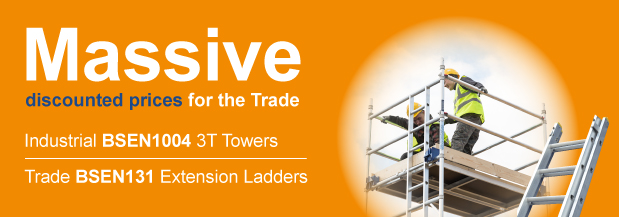Scaffold towers play a crucial role in construction and other industries, providing workers with a safe and secure platform to perform their tasks at height. However, like any equipment used in potentially hazardous environments, scaffold towers require regular inspections to ensure their safety and reliability. Understanding the importance of these inspections is essential for both employers and workers, as neglecting them can have severe legal implications and jeopardise the well-being of all parties involved.
Understanding the Importance of Scaffold Tower Inspections
Scaffold tower inspections are not just an additional administrative burden; they are a critical process in maintaining a safe working environment. The primary goal of these inspections is to identify any potential defects or safety risks before they can cause accidents or injuries. By proactively identifying and addressing issues, inspections contribute to the overall risk management strategy on construction sites.
The Role of Inspections in Ensuring Safety
Regular scaffold tower inspections help ensure that the equipment remains in good working condition. By identifying any faults or signs of wear and tear, these inspections allow for timely repairs or replacements. This proactive approach reduces the risk of accidents caused by faulty towers and maintains a safe environment for workers.
Inspections also play a crucial role in identifying potential hazards associated with the specific tasks being undertaken on the scaffold tower. For example, modifications made to the tower or nearby equipment may introduce new risks that need to be addressed. By thoroughly inspecting the tower, competent inspectors can recognise and address these hazards, improving worker safety.
Moreover, scaffold tower inspections provide an opportunity to assess the overall stability and structural integrity of the tower. Inspectors can examine the materials used, the assembly of the tower, and the adequacy of its foundations. This comprehensive evaluation ensures that the tower can withstand the intended loads and environmental conditions, minimising the risk of collapse or structural failure.
Legal Implications of Neglecting Inspections
Failure to conduct regular scaffold tower inspections can have serious legal consequences. In the UK, employers have a legal duty to ensure the health and safety of their employees, as outlined in the Health and Safety at Work Act 1974. By neglecting inspections, employers can be deemed in breach of this legislation, leading to fines, penalties, and potential litigation.
Furthermore, the Work at Height Regulations 2005 specifically emphasise the importance of regular inspections in the context of working at height. These regulations require employers to properly plan, supervise, and carry out work at height activities, including scaffold tower inspections. Neglecting these requirements can result in legal action and severe reputational damage for companies.
It is worth noting that scaffold tower inspections not only protect workers but also safeguard the public. In many construction sites, scaffold towers are erected near public areas, such as sidewalks or roads. Neglecting inspections increases the risk of accidents involving passersby, potentially exposing companies to legal liabilities and public backlash.
Moreover, the consequences of accidents resulting from neglected inspections go beyond legal and financial implications. Accidents can cause severe injuries or even fatalities, leading to immense emotional distress for the victims and their families. By prioritising scaffold tower inspections, employers demonstrate their commitment to the well-being of their workers and the community at large.
The UK Regulations on Scaffold Tower Inspections
Understanding the regulatory framework surrounding scaffold tower inspections in the UK is essential for employers and workers alike. The two primary regulations governing these inspections are the Work at Height Regulations 2005 and the Health and Safety at Work Act 1974.
The Work at Height Regulations 2005
The Work at Height Regulations 2005 aim to prevent accidents and injuries resulting from falls from height. These regulations were introduced to address the significant risks associated with working at height and to ensure that employers take appropriate measures to protect their workers.
Under these regulations, employers are required to conduct thorough risk assessments before any work at height is carried out. This includes assessing the suitability of scaffold towers for the specific task at hand. The risk assessment should consider factors such as the height of the tower, the nature of the work being carried out, and the experience and training of the workers involved.
In addition to risk assessments, the Work at Height Regulations also place a legal obligation on employers to provide suitable equipment for working at height. This includes ensuring that scaffold towers are of a suitable design and construction, and that they are properly maintained and inspected.
Scaffold tower inspections are a critical component of compliance with the Work at Height Regulations. These inspections should be carried out by competent individuals who have the necessary knowledge and experience to identify any defects or issues that could compromise the safety of the tower. Regular inspections are essential to ensure that any problems are identified and addressed promptly, reducing the risk of accidents or injuries.
The Health and Safety at Work Act 1974
The Health and Safety at Work Act 1974 outlines the general duties of employers to ensure the health, safety, and welfare of their employees. This legislation places a legal obligation on employers to provide a safe working environment, including safe equipment and regular inspections.
Under the Health and Safety at Work Act, employers are required to assess and manage the risks associated with the work carried out by their employees. This includes identifying any hazards, implementing control measures to mitigate those hazards, and regularly reviewing and updating these measures as necessary.
When it comes to scaffold tower inspections, the Health and Safety at Work Act requires employers to ensure that the equipment is regularly inspected and maintained in a safe condition. This includes conducting thorough inspections before each use, as well as regular periodic inspections to identify any wear and tear or damage that may have occurred over time.
Employers must appoint competent individuals to carry out these inspections, ensuring that they have the necessary knowledge, training, and experience to identify any defects or issues that could compromise the safety of the scaffold tower. Regular inspections are essential to ensure that any problems are detected and addressed promptly, reducing the risk of accidents or injuries.
In conclusion, compliance with the Work at Height Regulations 2005 and the Health and Safety at Work Act 1974 is crucial for employers to ensure the safety of workers working at height. Scaffold tower inspections play a vital role in meeting these regulatory requirements, as they contribute to the overall safety and well-being of workers. Employers must prioritise regular inspections, appoint competent individuals, and take prompt action to address any issues identified during these inspections.
The Inspection Process for Scaffold Towers
The inspection process for scaffold towers consists of various stages designed to thoroughly assess the equipment and identify any potential risks or defects. This process involves both pre-use inspections and regular inspections carried out during the use of the tower.
Ensuring the safety of scaffold towers is of utmost importance in the construction industry. These temporary structures provide workers with a stable platform to perform their tasks at elevated heights. To maintain their integrity and prevent accidents, scaffold towers must undergo rigorous inspections.
Pre-Use Inspections
Before each use, scaffold towers must undergo a pre-use inspection. This inspection involves checking key components such as platforms, handrails, and toe boards for any visible defects or damage. Additionally, it includes verifying the tower’s stability, ensuring that it has been properly erected and secured for safe use.
During pre-use inspections, a competent person, typically appointed by the employer, should perform a detailed assessment of the scaffold tower. This individual must possess extensive knowledge about scaffold towers and be familiar with the specific equipment being used. Their expertise allows them to identify potential hazards that may compromise the safety of the tower.
Inspectors meticulously examine each component of the scaffold tower, paying close attention to signs of wear and tear, corrosion, or structural damage. They also assess the stability of the tower by checking the base plates, braces, and tie-ins. Any identified defects or hazards must be promptly rectified or reported to the appropriate authority.
Regular Inspections and Their Frequency
In addition to pre-use inspections, regular inspections must be conducted periodically to ensure the ongoing safety of scaffold towers. The frequency of these inspections depends on various factors, such as the intensity of use, environmental conditions, and manufacturer recommendations.
Employers must appoint a competent person to carry out these regular inspections. This individual should possess a comprehensive understanding of scaffold towers and be able to identify potential risks that may arise over time. Regular inspections play a crucial role in preventing accidents and maintaining a safe working environment.
During regular inspections, the competent person thoroughly examines the scaffold tower, including all its components, connections, and stability. They assess the condition of the platforms, guardrails, and access points to ensure they meet safety standards. Additionally, they inspect the anchorage points, tie-ins, and bracing systems to verify their integrity.
Environmental factors, such as extreme weather conditions, can impact the structural integrity of scaffold towers. Therefore, regular inspections should also include an assessment of the tower’s ability to withstand these conditions. This may involve checking for signs of rust, water damage, or weakened materials.
Any identified issues during regular inspections must be addressed promptly to maintain a safe working environment. This may involve repairing or replacing damaged components, reinforcing weak areas, or adjusting the tower’s configuration to enhance stability.
By conducting thorough pre-use and regular inspections, employers can ensure the safety of scaffold towers and protect the well-being of their workers. These inspections not only comply with legal requirements but also contribute to a culture of safety in the construction industry.
Who is Qualified to Inspect Scaffold Towers?
Inspecting scaffold towers requires specific knowledge and skills to ensure a comprehensive assessment of the equipment’s safety. A competent person should be appointed to perform these inspections and possess the necessary expertise.
The Role of a Competent Person
A competent person is someone with the appropriate training, experience, and knowledge of scaffold tower inspections. They should be able to recognize potential hazards, identify defects, and understand the relevant regulatory requirements. This person plays a crucial role in maintaining the safety and integrity of scaffold towers on construction sites.
Training and Certification for Scaffold Inspectors
Proper training and certification for scaffold inspectors are essential to ensure their competence and understanding of industry best practices. Various training courses and certifications are available to help individuals acquire the necessary skills and knowledge to effectively inspect scaffold towers. Employers should ensure that their appointed inspectors have received appropriate training to perform their duties competently.
The Consequences of Failing to Inspect Scaffold Towers
Failure to conduct regular inspections for scaffold towers can have severe consequences for both employers and workers. Neglecting inspections increases the risk of accidents, injuries, and fatalities.
Potential Risks and Hazards
Without regular inspections, scaffold towers may develop defects or wear down over time, compromising their safety and stability. This can lead to various hazards such as collapsing platforms, unstable structures, or inadequate fall protection systems. Workers using these compromised towers are at a significantly higher risk of suffering serious injuries or even fatalities.
Legal Penalties and Fines
Non-compliance with scaffold tower inspection requirements can result in substantial legal penalties and fines. Employers may face enforcement action from regulatory bodies, such as the Health and Safety Executive (HSE), which can lead to significant financial consequences. Furthermore, companies that neglect inspections may experience reputational damage, hindering their ability to secure future contracts or maintain a positive image within the industry.
Conclusions
In conclusion, scaffold towers in the UK require regular inspections to ensure their safety and the well-being of workers. Understanding the importance of these inspections, the applicable regulations, and the consequences of neglecting them is crucial for employers and workers alike. By prioritising scaffold tower inspections and appointing competent individuals to carry them out, companies can create a safer working environment and avoid potentially devastating accidents and legal repercussions.


